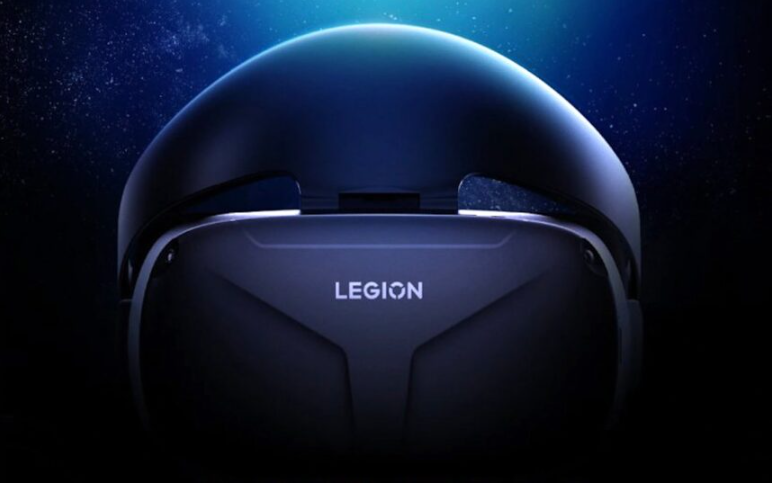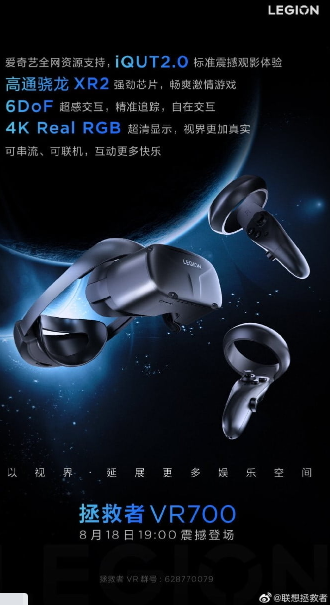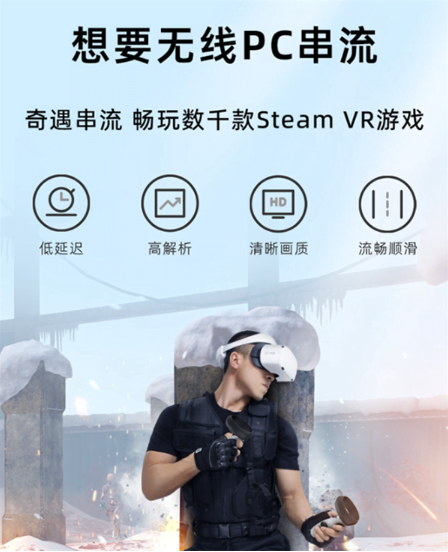Lenovo Presents Its New Standalone VR700 Headset
Lenovo has presented a new standalone virtual reality headset with technical specs which not unlike those of the Quest 2 headset.
The new Lenovo headset is powered by the Qualcomm XR2 mobile chip and is, thus, built to run without an external device. The headset also provides spatial tracking through four integrated cameras as well as an LC display that has 4K resolution. The headset’s battery attaches to the back of the head mount.

Lenovo is launching the virtual reality headset at the same time as its Lenovo Legion Y70, a mid-range smartphone. The Legion Y70 launches in a few days.
Lenovo hasn’t stated the markets where the Lenovo VR700 headset will be sold.
Lenovo teased its new VR700 virtual reality headset in a Chinese language poster. The headset will be Lenovo’s latest entry in its lineup of Legion virtual reality gaming hardware.

There isn’t much detail on the headset in the Chinese language poster although it shows its front plate and head strap. Also, the advertisement doesn’t reveal whether this headset will be available outside China.
The VR700 standalone VR headset will be powered by Qualcomm chips like the other hardware offerings in Lenovo’s line. Lenovo has had a longstanding partnership with Qualcomm. Lenovo has also partnered with the chipmaker through Qualcomm’s Snapdragon Spaces platform for extended reality software and hardware production.

Lenovo is revealing the headset at a time when many other XR hardware firms are in a race to build the next killer headset. While Meta has faced challenges in the past few months, the company is currently on track to launch its Project Cambria mixed reality (MR) headset this year.
At the same time, Valve is also planning to launch its Deckard device, the successor to the widely popular Valve Index virtual reality headset. The Deckard device is still shrouded in mystery and there have only been a few leaks so far.
The teaser for the Lenovo VR700 device mentions “iQUT 2.0” which is likely the company’s streaming offering in partnership with the Chinese online video platform iQiyi. iQiyi also has its own virtual reality headset version known as the Qiyu Dream Pro which has the same specifications and an almost similar design.
The Qiyu Dream Pro headset is also powered by the XR2 chipset and packs 8GB of RAM along with an RGB LC display that offers a refresh rate of up to 90Hz at 3664 x 1920 pixels resolution along with a pixel density of 773 ppi.
The Dream Pro headset comes in 128GB and 256GB. The headset also supports wireless PC streaming through SteamVR. It is priced at $360 and $450 based on the storage size.
The VR700 headset could be Lenovo’s version of the Dream Pro. Lenovo will be officially unveiling the VR700 on August 18.
Lenovo launched a number of virtual reality headsets between 2017 and 2019. Its first VR headset was based on the Windows Mixed Reality Platform, accompanied by the PC device Lenovo Explorer. Later, it launched the headset in Google’s Daydream ecosystem with its standalone Lenovo Mirage Solo VR headset.
The Lenovo Mirage Solo headset was a technically proficient headset and used Google software for its tracking functions. The Lenovo Mirage Solo headset even had passthrough AR before Meta (then Facebook) added the same feature in its Oculus Quest headset. The Lenovo headset didn’t have its software and only had a simple remote control in place of gaming controllers.
Both of these headsets did not take off.
Lenovo’s most successful VR hardware entry was in its partnership with Oculus in 2019 where it provided the headset design for the relatively successful Oculus Rift S headset which has been one of the best-selling PC VR headsets. The Oculus Rift S headset was discontinued in 2020 but it remains one of the most used PC VR headsets.
https://virtualrealitytimes.com/2022/08/12/lenovo-presents-its-new-standalone-vr700-headset/https://virtualrealitytimes.com/wp-content/uploads/2022/08/VR700-600x375.pnghttps://virtualrealitytimes.com/wp-content/uploads/2022/08/VR700-150x90.pngHardwareVR HeadsetsLenovo has presented a new standalone virtual reality headset with technical specs which not unlike those of the Quest 2 headset. The new Lenovo headset is powered by the Qualcomm XR2 mobile chip and is, thus, built to run without an external device. The headset also provides spatial tracking through...Rob GrantRob Grant[email protected]AuthorVirtual Reality Times - Metaverse & VR
